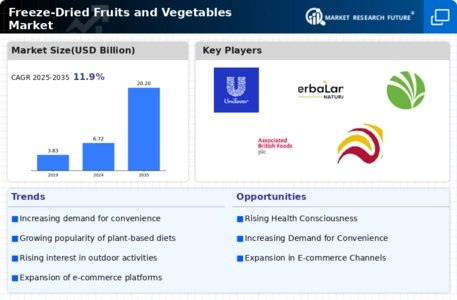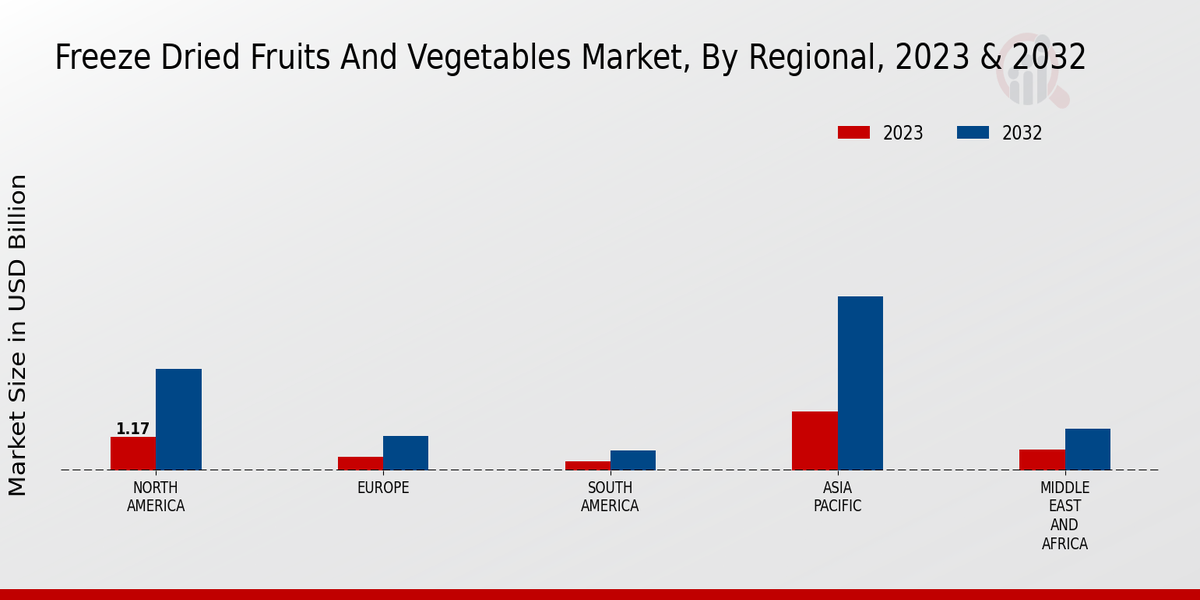Rising Health Consciousness
The Global Freeze-Dried Fruits and Vegetables Market Industry is experiencing a surge in demand driven by an increasing awareness of health and nutrition among consumers. As individuals seek healthier snack alternatives, freeze-dried fruits and vegetables are perceived as nutritious options that retain essential vitamins and minerals. This trend is particularly evident in regions with high health consciousness, such as North America and Europe. The market is projected to reach 6.72 USD Billion in 2024, reflecting a growing preference for convenient, healthy food choices. The emphasis on clean label products further supports this trend, as consumers increasingly scrutinize ingredient lists.
Market Trends and Projections
The Global Freeze-Dried Fruits and Vegetables Market Industry is poised for substantial growth, with projections indicating a market value of 6.72 USD Billion in 2024 and an anticipated increase to 20.2 USD Billion by 2035. This growth trajectory suggests a compound annual growth rate of 10.53% from 2025 to 2035. Various factors, including rising health consciousness, convenience, and innovative product development, contribute to this positive outlook. The market's expansion is expected to be particularly pronounced in emerging economies, where changing consumer preferences and increased disposable incomes are likely to drive demand for freeze-dried products.
Innovative Product Development
Innovation in product development is a key driver for the Global Freeze-Dried Fruits and Vegetables Market Industry. Manufacturers are continually exploring new flavors, combinations, and packaging solutions to attract diverse consumer segments. For example, the introduction of freeze-dried smoothie packs and meal kits caters to the growing demand for convenient, nutritious options. Additionally, advancements in freeze-drying technology enhance product quality and flavor retention, further appealing to consumers. This focus on innovation is likely to contribute to a compound annual growth rate of 10.53% from 2025 to 2035, indicating a robust future for the industry as it adapts to evolving consumer preferences.
Convenience and Shelf Stability
Convenience plays a pivotal role in the growth of the Global Freeze-Dried Fruits and Vegetables Market Industry. Freeze-dried products offer extended shelf life and lightweight packaging, making them ideal for on-the-go consumption and emergency preparedness. This convenience appeals to busy consumers and outdoor enthusiasts alike. For instance, freeze-dried meals are popular among campers and hikers due to their ease of preparation and storage. The market's expansion is further supported by the increasing availability of these products in retail outlets and online platforms, enhancing accessibility. As a result, the market is anticipated to grow significantly, potentially reaching 20.2 USD Billion by 2035.
Growing Demand in Emerging Markets
Emerging markets are increasingly contributing to the growth of the Global Freeze-Dried Fruits and Vegetables Market Industry. As urbanization accelerates and disposable incomes rise in regions such as Asia-Pacific and Latin America, consumers are becoming more open to trying new food products. The convenience and nutritional benefits of freeze-dried fruits and vegetables resonate well with these evolving consumer habits. Furthermore, local manufacturers are beginning to invest in freeze-drying technology, enhancing the availability of these products. This trend suggests that the market will continue to expand, driven by both local demand and international exports, thereby diversifying the global market landscape.
Sustainability and Environmental Awareness
Sustainability is emerging as a crucial factor influencing the Global Freeze-Dried Fruits and Vegetables Market Industry. Consumers are increasingly concerned about the environmental impact of their food choices, leading to a preference for products that are sustainably sourced and produced. Freeze-drying is often viewed as a more environmentally friendly preservation method compared to traditional canning or freezing, as it requires less energy and reduces food waste. Companies that prioritize sustainable practices in their supply chains are likely to gain a competitive edge. This growing emphasis on sustainability may further drive market growth as consumers align their purchasing decisions with their values.







